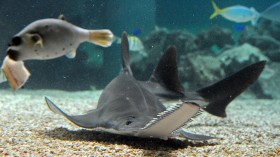Two-toned cats get their distinctive, and seemingly random, black-and-white (piebald) patches from "faulty" genes, according to a recent study led by researchers from the Universities of Bath and Edinburgh
Piebald patches, also apparent in some horses, occur when pigment cells move and multiply randomly as an embryo grows, without complex cell-to-cell communication sending them in one direction. Researchers note their findings may ultimately shed light on other medical conditions that occur during early development stages, such as holes in the heart, which are caused by cells not moving to the right place as an embryo develops, according to a news release.
''We already know cells move through the developing skin to create pigment. We have discovered that they move and multiply at random which is not what was expected. Using a mathematical model we were then able to show that this simple process could explain piebald patterns," Dr. Richard Mort, one of the study researchers from the University of Edinburgh's Medical Research Council Human Genetics Unit, explained in the release.
For their study, researchers examined how pigment cells behave in mice. Their findings contradict previous theories suggesting this odd fur coloring is the result of slow-moving pigment cells.
"Piebald patterns can be caused by a faulty version of a gene called kit. What we have found is counter intuitive. Previously it was thought that the defective kit gene slowed cells down but instead we've shown that it actually reduces the rate at which they multiply," Dr. Christian Yates, a Mathematical Biologist from the University of Bath, added in the university's release. "There are too few pigment cells to populate the whole of the skin and so the animal gets a white belly. In addition to kit, there are many other genes that can create piebald patterns, the mathematical model can explain piebald patterns regardless of the genes involved.''
Their study was recently published in the journal Nature Communications.
Related Articles
Cats Can Interpret Their Owner's Emotions, New Study Reveals
For more great nature science stories and general news, please visit our sister site, Headlines and Global News (HNGN).
-Follow Samantha on Twitter @Sam_Ashley13
© 2024 NatureWorldNews.com All rights reserved. Do not reproduce without permission.
![Severe Thunderstorm Alert: Tornadoes, Damaging Winds and Hail Possible from Upper Ohio Valley to Northeast US [NWS]](https://1471793142.rsc.cdn77.org/data/thumbs/full/70161/280/157/50/40/severe-thunderstorm-alert-tornadoes-damaging-winds-and-hail-possible-from-upper-ohio-valley-to-northeast-us-nws.jpg)




